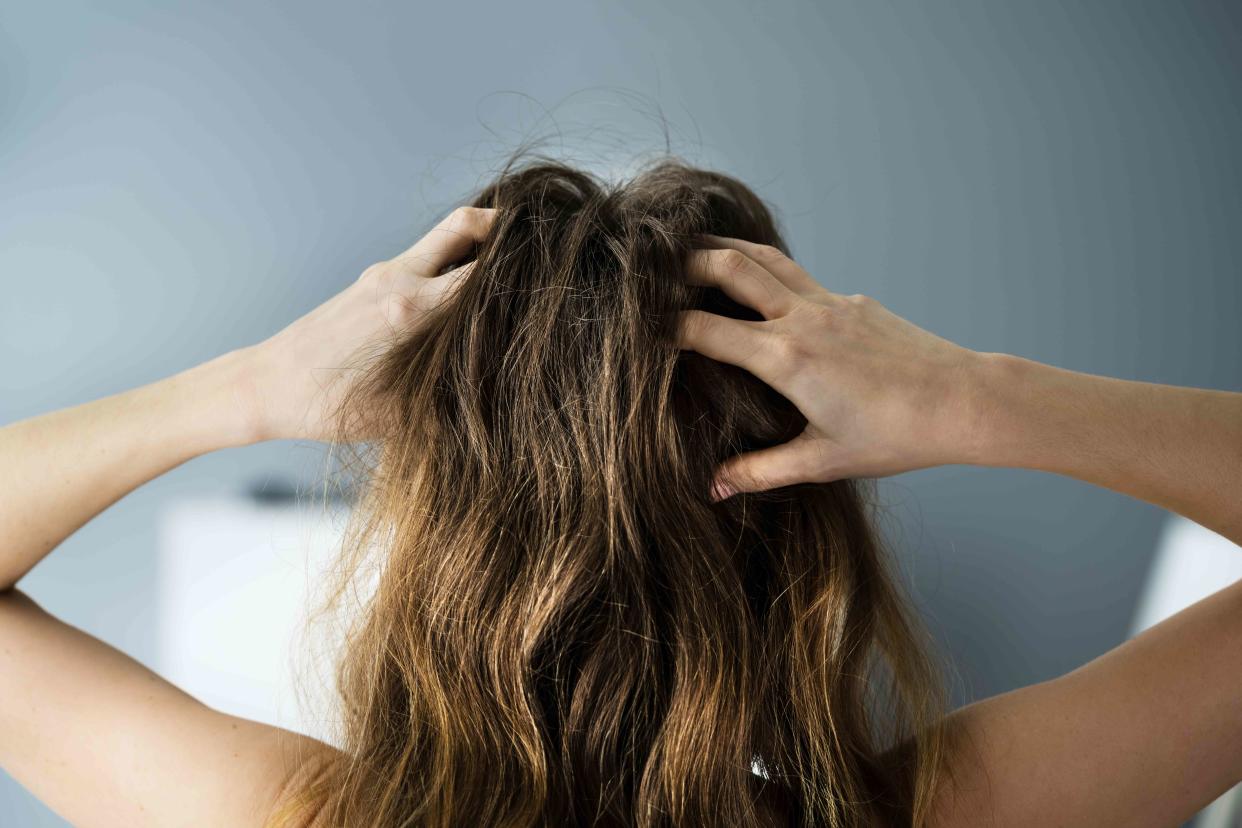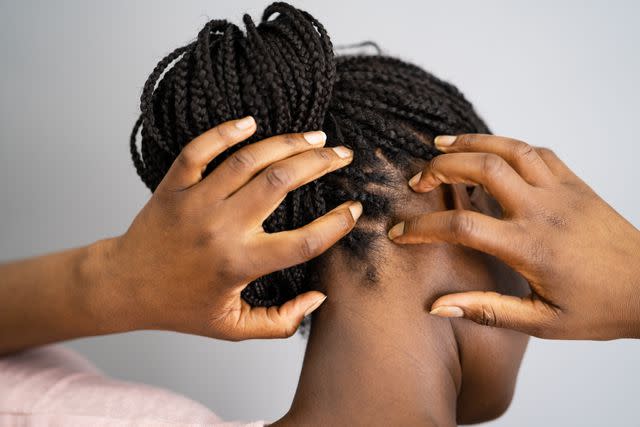How to Moisturize Your Scalp: 3 Easy Methods

Getty Images
If you’re prone to dry skin, you likely have a face-to-toe regimen loaded with cleansers, serums, and creams designed to restore much-needed hydration. But you’re also probably wondering how to moisturize your scalp. This oft-neglected area definitely deserves pampering, too: Without enough moisture, your scalp will feel tight, itchy, and uncomfortable, start to flake, and can even cause hair breakage over time.
Related: The 17 Best Scalp Treatments to Stay Balanced, Nourished, and Itch-Free
While moisturizing your scalp may seem like a real chore at first blush, the truth is that it only takes a few switches to your regular routine to keep everything balanced above your hairline. Here, we’ve tapped the expertise of trichologist and scalp therapist Bridgette Hill and board-certified dermatologist Dr. Dhaval G. Bhanusali to help you keep your scalp moisturized, comfortable, and flake free — all without the risk of greasy-looking strands.
Meet Our Expert
Bridgette Hill is a trichologist and scalp therapist based in West Palm Beach, Florida.
Dr. Dhaval G. Bhanusali is a board-certified dermatologist based in New York City.
Determine the Cause
Before you can effectively moisturize your scalp, you need to know why your scalp is dry. “A dry scalp means there is a depletion in its moisturizing agent, which is sebum,” explains Hill. This could be caused by environmental factors, such as using excessively hot water, washing too frequently, or exposure to dry, stripping air, or styling habits, your lifestyle and diet, stress, and medical conditions. “The most common causes of dry scalp that we see in the office are seborrheic dermatitis and, less frequently, psoriasis,” says Dr. Bhanusali. Dandruff is also a common scalp issue that results in dryness.
Tips
You’ll be able to tell the difference between a standard dry scalp that can be treated by moisturization and one caused by a condition that needs more significant intervention by the size of the flakes.
“I like to use the analogy of dried seasonings,” says Hill. “Flakes from dehydrated and dry scalps are more analogous to salt granules,” she says. Those from dandruff, seborrheic dermatitis, and psoriasis will be larger and thicker. While dandruff and seborrheic dermatitis have the same root cause — an overproduction of the yeast Malassezia furfur — the latter is a far more advanced case that may spread to other parts of the body, including the eyebrows, and causes inflammation. “Psoriasis tends to result in much thicker flakes and is accompanied by severe itch,” says Dr. Bhanusali. This condition is genetic and psoriasis can’t be cured; its symptoms can be controlled.
Create a Custom Routine
To keep your scalp moisturized, you need to tailor your regimen to your scalp’s needs. “Dry scalps need the sebum not to be removed from the scalp, so look for balancing shampoos that aren’t harsh, are sulfate-free, and retain the balance of the microbiome,” says Hill. That means no clarifying shampoos — they strip not just product buildup, but oil from the hair and scalp.
Hill likes gentle shampoos that feature ingredients that are rich in fatty acids, like avocado and shea, as well as amino acids, but are not too heavy in texture. Glycerin may also boost the hydration levels of your scalp, says Dr. Bhanusali. Hours The Daily Moisturizing Shampoo ($32) is formulated with avocado oil to maintain scalp balance and moisture levels, while amino acids like histadine, alanine, and valine help support your skin’s natural moisturizing factors.
Hill also recommends Klorane Oat Milk Gentle Shampoo ($22) due to the soothing and nourishing properties of oat. “Continual replenishment of moisture and maintaining a hydrated, balanced microbiome are key factors in keeping the skin on the scalp healthy, nourished, and feeling great,” she says.
Related: The 12 Best Scalp Scrubs of 2023
If you’re dealing with dryness because of dandruff, seborrheic dermatitis, or even psoriasis (the latter two can overlap to cause a condition called sebo-psoriasis), Dr. Bhanusali recommends a shampoo with ketoconazole, which will control the overgrowth of yeast on the scalp while soothing itching and reducing scaling. Try Nizoral Anti-Dandruff Shampoo ($12), which contains one percent ketoconazole. He also likes Selsun Blue Shampoo ($9), formulated with selenium sulfide to tame yeast growth, irritation, and flaking.
Your choice of conditioners and stylers should be tailored to your hair type, but be sure to avoid dry shampoo whenever possible. “We see dry scalp most frequently in those who use dry shampoos and powders too often,” says Dr. Bhanusali. These products are designed to absorb oil, leaving your scalp dehydrated. Lastly, use gentle hot tools like Hill’s device of choice, the Dyson Supersonic Hair Dryer ($429), which limits heat exposure to the scalp, especially with special attachments that regulate the force of airflow.

Getty Images
Moisturize From the Inside Out
Though it sounds obvious, your scalp is skin, too, and a healthy diet supports healthy skin function. Hill recommends eating more foods that are rich in fatty acids. Studies show that compounds in omega-3 fatty acids can positively influence the skin barrier, decrease water loss, maintain hydration levels, and reduce inflammation. You can find omega-3 fatty acids in fish like salmon, mackerel, and sardines as well as flaxseed, walnuts, and eggs.
And, though you’re probably sick of hearing this, drink more water by any means necessary. We’d always thought that staying hydrated really only helped our bodies function at peak performance by helping flushing out toxins, but a study from 2015 shows that drinking water positively impacts our skin’s function, too. Adding electrolytes into the mix will boost your body’s ability to help navigate that hydration to exactly where it needs to go. BodyHealth Perfect Amino Electrolytes ($40) is easily blended into hot or cold water, tastes great, and uses stevia and monk fruit as sweeteners (better for your skin than added sugar!).
Frequently Asked Questions
What ingredients help moisturize the scalp?
Beyond ingredients like glycerin, avocado, oat, and shea, look for clay, cherry, and apple cider vinegar, says Hill, which help to soothe and rebalance. She also is a big fan of hyaluronic acid. “The lightweight, hydrating water-binding properties are ideal for the scalp and can be used by all scalp types and conditions,” says Hill.
How can I moisturize my scalp without making my hair greasy?
When treating clients with dry scalp, Hill always recommends they shop for an oil-based pre-shampoo scalp treatment. “They allow for the scalp to be hydrated and nourished, and the excess product gets washed away during the shampoo step,” she says.
What kind of habits make the scalp dry?
Anything that strips away your sebum can make your scalp dry. If you’re prone to a dry, itchy scalp during the cooler months, there’s a reason for this: There’s less moisture in winter air, which makes it hard for your scalp to stay balanced. When you pair the weather with the urge to warm up using hot showers, which remove natural oils from the skin, you’re creating the perfect recipe for a dry scalp. Going in the sun unprotected can also leave your scalp susceptible to damage, as can harsh hair treatments like chemical processing and coloring.
How do I moisturize my scalp when I wear a protective style, braids, or a wig?
Those with natural hair know that washing their strands will strip them of natural moisture and could cause damage, but a dry scalp needs to be cared for regularly. Hill suggests using naturally cleansing oils like rosemary, applied weekly with an applicator bottle that features a nozzle. “Some scalps may need a diluted shampoo every other week or so,” she says.
For more InStyle news, make sure to sign up for our newsletter!
Read the original article on InStyle.

